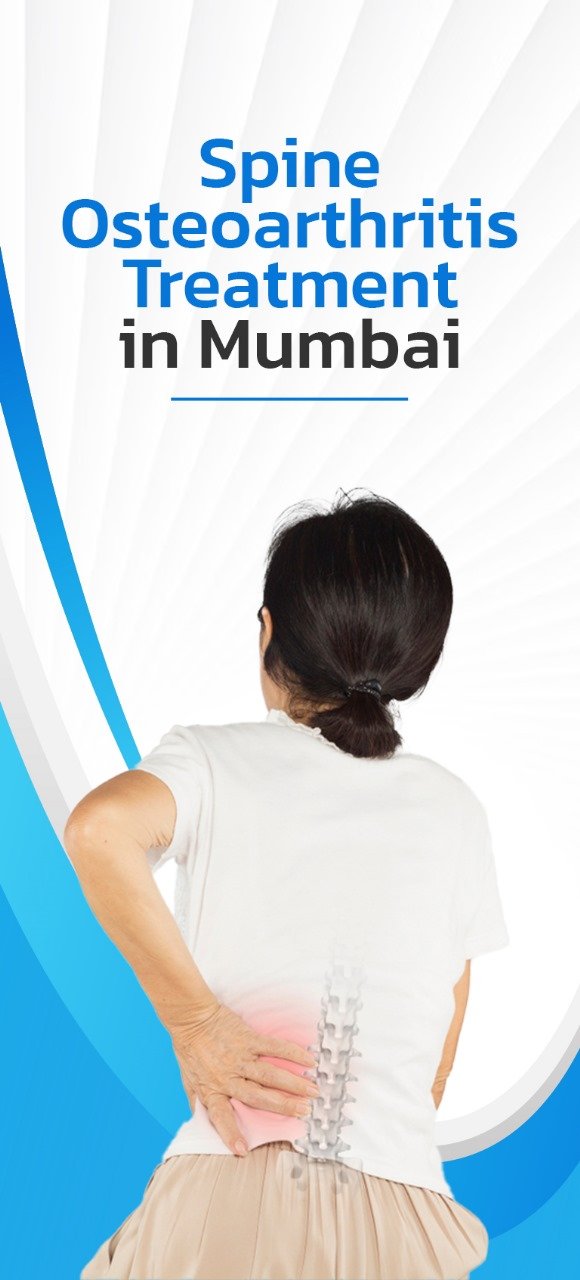

Revolutionizing Spinal Health: An In-Depth Look at Advanced Therapies for Spine Osteoarthritis Treatment in Mumbai's Specialized Clinics
Osteoarthritis, a prevalent form of arthritis, affects people globally as the protective cartilage between bone ends wears away over time. Dr. Priyank Patel, an expert at The Spine Clinic in Mumbai, specializes in spine osteoarthritis treatment in Mumbai, offering medications, therapies, and surgical interventions when needed. While symptoms like pain and stiffness may not be fully reversible, early intervention and effective care can significantly alleviate discomfort and enhance the quality of life for individuals dealing with osteoarthritis.

Looking for osteoarthritis treatment in Mumbai? Consult Dr. Priyank Patel,
Are you in search of an effective and comprehensive Spine osteoarthritis treatment in Mumbai for your spine? Look no further—consulting with Dr. Priyank M Patel is your key to expert care. Specializing in both surgical and non-surgical management of spine-related disorders, Dr. Patel brings a wealth of experience, particularly in the nuanced field of spine tumors. Notably recognized as one of the youngest independent surgical consultants in India, Dr. Patel has earned empanelment in a leading tertiary hospital in Mumbai. His extensive international training encompasses complex surgical procedures, including minimally invasive spinal surgery, computer-assisted spinal surgery, microsurgery, athletic spinal injuries, and motion-preserving procedures like artificial disc replacement.
Despite his surgical prowess, Dr. Patel emphasizes a conservative approach when possible, advocating for an active lifestyle with corrective exercise and strength and conditioning coaching. His commitment to patient well-being extends beyond his role as a surgeon; he has successfully treated professional athletes from the Indian National Cricket Team and the film industry, enabling them to perform at their peak despite injuries. Dr. Patel’s expertise has earned him recognition on the international stage, with invitations to speak at the World Congress on Spine and Related Disorders. As a senior consultant acknowledged by various national and international spine organizations, Dr. Patel’s dedication goes beyond individual care—he is actively involved in nurturing new surgeons and spearheading philanthropic initiatives like setting up Rural Spine Care Centers across India, especially for tribal societies. Looking ahead, his vision includes establishing a National Spine Tumor Foundation, addressing critical cases related to spine tumors, and contributing significantly to the enhancement of the country’s health landscape. Choose Dr. Priyank M. Patel for Spine osteoarthritis treatment in Mumbai and benefit from his unparalleled expertise and commitment to holistic spine care.
Understanding Osteoarthritis
Osteoarthritis, commonly known as OA, is a widespread form of arthritis affecting people globally. This degenerative condition manifests when the protective cartilage that cushions the ends of bones gradually wears away over time. The impact is most pronounced in joints such as hands, knees, hips, and the spine.
- Symptoms: The symptoms associated with osteoarthritis are not reversible and include pain, stiffness, tenderness, and limited flexibility.
- Prevalence: Osteoarthritis is a prevalent condition that affects numerous individuals worldwide.
- Affected Joints: The joints most significantly impacted by osteoarthritis include the hands, knees, hips, and spine.
- Management Strategies: While the symptoms may not be fully reversible, various strategies and treatments, including spine osteoarthritis treatment in Mumbai, can be employed to manage and alleviate them.
- Quality of Life: The ultimate goal of managing osteoarthritis is to contribute to an improved quality of life for individuals dealing with the condition. Understanding the nature of osteoarthritis is crucial for those seeking effective ways to cope with its challenges and enhance their overall well-being. In some cases, surgical interventions like spine osteoarthritis surgery in Mumbai may be recommended for more severe conditions.

Types of osteoarthritis
Osteoarthritis, a prevalent form of arthritis, can manifest in different types based on the affected joints and underlying causes. Understanding these variations is crucial for accurate diagnosis and tailored treatment approaches-
Localized Osteoarthritis
- It affects specific joints, such as the hands, knees, or hips.
- Commonly associated with wear and tear in the affected joint.
Generalized Osteoarthritis
- Involves multiple joints throughout the body.
- Often associated with aging and genetic factors.
Secondary Osteoarthritis
- Results from underlying conditions or injuries, such as joint injuries or inflammatory joint diseases.
- Can affect various joints, depending on the specific cause.
Erosive Osteoarthritis
- Characterized by more severe joint damage, including erosion of the bone.
- It typically affects the hands, particularly the interphalangeal joints.
Primary Osteoarthritis
- It occurs without any apparent cause or underlying condition.
- Usually associated with aging and the natural degeneration of joints.
Post-Traumatic Osteoarthritis
- Develops after joint injuries, fractures, or trauma.
- Common in joints that have experienced significant stress or damage.
Secondary to congenital disorders
- Arises as a result of congenital joint abnormalities.
- Joints may be predisposed to premature degeneration.
Understanding the specific type of osteoarthritis a person is experiencing is vital for creating a personalized treatment plan that addresses the unique characteristics and challenges associated with each subtype. For individuals dealing with spine-related osteoarthritis, consulting with a specialized spine osteoarthritis surgeon in Mumbai can provide tailored insights and treatment options. Additionally, considerations like spine osteoarthritis surgery cost in Mumbai may be important factors in decision-making for those exploring surgical interventions.
How common is osteoarthritis?
Osteoarthritis is a highly prevalent condition that affects a significant number of individuals globally, with its frequency notably increasing as people age.
Age-Related Prevalence
- Osteoarthritis becomes more common among older adults.
- The risk of developing the condition tends to rise with advancing age.
Global Impact
- Osteoarthritis is recognized as one of the most widespread forms of arthritis.
- It impacts millions of people across diverse populations.
Risk Factors
- Various factors contribute to the development of osteoarthritis, including aging, genetics, joint injuries, and obesity.
- Understanding these risk factors is crucial for both prevention and management strategies.
Changing Demographics
- As societies age and lifestyles evolve, the prevalence of osteoarthritis is expected to increase.
- This shift emphasizes the need for proactive measures in healthcare to address the growing impact of osteoarthritis on public health.
Recognizing the commonality of osteoarthritis underscores the importance of widespread awareness, early intervention, and comprehensive management strategies to enhance the quality of life for those affected by this prevalent condition. When seeking support, consider consulting with the best doctor for spine osteoarthritis in Mumbai, who can provide specialized care. A dedicated spine osteoarthritis doctor in Mumbai can offer valuable insights and personalized treatment options for individuals dealing with this condition.

Symptoms of osteoarthritis
Osteoarthritis manifests through a range of distinctive symptoms, often affecting various joints in the body. While these symptoms may develop gradually and worsen over time, they serve as key indicators of the condition.
Joint Pain
- Persistent pain in the affected joints, which may intensify during or after movement.
- Pain can vary from a dull ache to sharp discomfort.
Stiffness
- Joint stiffness, especially after periods of inactivity or rest.
- Stiffness tends to improve with movement but can recur after prolonged rest.
Tenderness
- Tenderness when applying light pressure to the affected joint.
- Touching or pressing on the joint may elicit discomfort.
Reduced Range of Motion
- Diminished flexibility and a reduced range of motion in the affected joint.
- Difficulty in performing regular activities that require joint movement.
Grating Sensation
- A grating or scraping sensation within the joint during movement.
- This may be accompanied by audible sounds, such as clicks or pops.
Bone Spurs
- Development of bony lumps or bone spurs around the affected joint.
- These may be felt under the skin and contribute to joint deformities.
Joint Swelling
- Swelling or enlargement of the joint, indicating inflammation.
- Swelling can vary in severity and may be intermittent.
Instability
- A sense of joint instability or a feeling that the joint may give way.
- This can impact balance and stability during movement.
Recognizing these symptoms is crucial for an early diagnosis and effective management of osteoarthritis. If you experience persistent joint-related discomfort or notice changes in joint function, seeking the expertise of a spine osteoarthritis specialist in Mumbai is recommended. They can offer specialized insights and personalized care, ensuring the best treatment for spine osteoarthritis in Mumbai based on your individual needs.

Causes of Osteoarthritis
Osteoarthritis, a degenerative joint condition, results from a combination of factors that contribute to the breakdown of the protective cartilage in the joints. Understanding the various causes of osteoarthritis is essential for effective management and prevention.
Aging
- The natural aging process is a primary contributor to the development of osteoarthritis.
- Over time, wear and tear on joints can lead to the deterioration of cartilage.
Joint Injury
- Previous joint injuries, such as fractures or ligament tears, increase the risk of osteoarthritis.
- Trauma to the joint can disrupt the normal balance of cartilage and contribute to its breakdown.
Obesity
- Excess body weight places additional stress on weight-bearing joints, such as the knees and hips.
- This increased load can accelerate the degeneration of cartilage.
Genetics
- Genetic factors can influence the likelihood of developing osteoarthritis.
- Individuals with a family history of the condition may be more predisposed to it.
Joint Overuse
Repetitive and excessive use of certain joints, commonly observed in occupations or activities that involve repetitive motions, can contribute to osteoarthritis.
Muscle Weakness
- Weak muscles surrounding the joints may fail to provide adequate support.
- This lack of support can lead to joint instability and increased stress on cartilage.
Joint congenital abnormalities
- Individuals born with joint abnormalities or malformations may be at a higher risk of developing osteoarthritis.
- These structural irregularities can impact the even distribution of forces within the joint.
Other health conditions
Certain health conditions, such as metabolic disorders and inflammatory joint diseases, can contribute to the development of osteoarthritis.
Understanding the multifaceted causes of osteoarthritis allows for a more comprehensive approach to its management, considering both preventive measures and targeted interventions, including spine osteoarthritis treatment in Mumbai. In cases where conservative measures are insufficient, individuals may explore options such as spine osteoarthritis surgery in Mumbai for more advanced intervention.
Risk Factors for Osteoarthritis
Osteoarthritis is influenced by various risk factors that contribute to the likelihood of developing this degenerative joint condition. Identifying these risk factors is crucial for understanding susceptibility and implementing preventive measures.
- Age: The risk of osteoarthritis increases with age, and it is more prevalent among older adults.
- Gender: Osteoarthritis tends to affect women more commonly than men, particularly after the age of 50.
- Genetics: Individuals with a family history of osteoarthritis may have a higher predisposition to the condition.
- Joint Injuries: Previous joint injuries, such as fractures or ligament tears, elevate the risk of osteoarthritis in the affected joint.
- Obesity: Excess body weight places added stress on joints, particularly weight-bearing joints like the knees and hips.
- Occupation and Joint Overuse: Certain occupations or activities involving repetitive joint movements may increase the risk of osteoarthritis.
- Muscle Weakness: Weak muscles around the joints can contribute to joint instability, leading to increased stress on cartilage.
- Joint congenital abnormalities: Individuals born with joint abnormalities or structural irregularities may have an elevated risk.
- Other health conditions: Certain conditions, such as metabolic disorders and inflammatory joint diseases, may be associated with an increased risk of osteoarthritis.
- Lifestyle Factors: Sedentary lifestyles and a lack of regular exercise may contribute to the development of osteoarthritis.
- Bone Deformities: Structural abnormalities in the bones can impact joint mechanics and increase susceptibility to osteoarthritis.
Recognizing these risk factors enables healthcare professionals to assess an individual’s likelihood of developing osteoarthritis and tailor preventive strategies accordingly. Proactive measures, such as weight management, exercise, and joint protection, can mitigate these risk factors and contribute to the prevention of osteoarthritis or the management of its progression. In instances where osteoarthritis has already developed, seeking specialized care, including spine osteoarthritis treatment in Mumbai, becomes essential for effective and targeted management.
Diagnosis of Osteoarthritis
Diagnosing osteoarthritis involves a comprehensive evaluation by healthcare professionals to assess symptoms, joint function, and potential contributing factors. The diagnostic process combines clinical assessments, imaging studies, and consideration of the patient’s medical history.
Key Steps in Diagnosis
- Medical History: Gathering information about the patient’s medical background, including symptoms, joint pain, and any relevant factors.
- Physical Examination: Conducting a thorough physical examination to evaluate joint function, range of motion, tenderness, and visible signs of osteoarthritis.
- Imaging Studies: Utilizing X-rays to visualize affected joints, identifying cartilage loss, bone spurs, or joint deformities.
- Joint Aspiration (Arthrocentesis): Extracting a small joint fluid sample using a needle to rule out other joint conditions, such as inflammatory arthritis.
- Blood Tests: Conducting specific blood tests to eliminate other types of arthritis, although there is no direct blood test for osteoarthritis.
- Symptom Assessment: Evaluating the nature and duration of joint pain, stiffness, and functional limitations reported by the patient.
- Diagnostic Criteria: Applying criteria established by organizations like the American College of Rheumatology to confirm the diagnosis based on a combination of symptoms and imaging findings.
- Exclusion of Other Conditions: Ruling out other joint conditions, such as rheumatoid arthritis or gout, which may present with similar symptoms.
An accurate diagnosis is crucial for tailoring an effective treatment plan that addresses the specific needs of the individual. It enables healthcare professionals to manage symptoms, slow disease progression, and enhance the overall quality of life for those affected by osteoarthritis. For individuals seeking specialized care, consulting with the best doctor for spine osteoarthritis in Mumbai is recommended. Specialized insights and personalized treatment options can significantly contribute to the effective management of spine-related osteoarthritis.
Osteoarthritis Treatment Options
Osteoarthritis treatment aims to manage symptoms, improve joint function, and enhance the overall quality of life for individuals affected by this degenerative condition. Treatment plans are tailored based on the severity of symptoms, the affected joints, and the individual’s specific needs. Several therapeutic approaches and interventions are commonly employed in osteoarthritis management.

Lifestyle Modifications
- Weight Management: Maintaining a healthy weight reduces stress on weight-bearing joints, such as the knees and hips.
- Exercise: Regular physical activity helps improve joint flexibility, strengthen muscles, and alleviate stiffness.
- Joint Protection: Implementing strategies to protect joints during daily activities can reduce the risk of further damage.
Medications
- Pain Relievers: Over-the-counter or prescription pain medications, such as acetaminophen or nonsteroidal anti-inflammatory drugs (NSAIDs), help manage pain and inflammation.
- Topical Analgesics: Creams or patches containing analgesic ingredients may provide localized pain relief.
Physical and Occupational Therapy
- Physical Therapy: Customized exercises and stretching routines can improve joint function and alleviate pain.
- Occupational Therapy: Techniques to optimize daily activities and minimize joint strain are taught to enhance overall functionality.
Assistive Devices
- Joint Braces: Braces or splints may offer support and reduce joint strain, particularly for knee osteoarthritis.
- Canes or walking aids: Assistive devices help distribute weight and improve stability during movement.
Injections
- Corticosteroid Injections: Intra-articular injections of corticosteroids provide anti-inflammatory effects and temporary pain relief.
- Hyaluronic Acid Injections: This viscous fluid is injected into the joint to improve lubrication and reduce friction.
Surgical Interventions
- Arthroscopy: minimally invasive procedures to repair or remove damaged joint tissue.
- Joint Replacement: In severe cases, joint replacement surgery, such as knee or hip replacement, may be considered.
Complementary Therapies
- Acupuncture: Fine needles are inserted into specific points to alleviate pain and improve energy flow.
- Dietary Supplements: Some individuals find relief with supplements like glucosamine and chondroitin.
Individuals with osteoarthritis may benefit from a combination of these treatment options, and the approach is often personalized to address their unique circumstances. For those dealing specifically with spine-related osteoarthritis, seeking consultation with a specialized spine osteoarthritis doctor in Mumbai can provide valuable insights and guidance on tailored treatment plans, including considerations for spine osteoarthritis treatment in Mumbai. Regular communication with healthcare professionals ensures ongoing evaluation and adjustments to the treatment plan as needed.
Advantages of Osteoarthritis Treatment in Mumbai
Seeking osteoarthritis treatment in Mumbai offers several distinct advantages, enhancing the overall patient experience and contributing to effective care.
- Advanced Technology: Mumbai’s healthcare facilities leverage cutting-edge technologies in the diagnosis and treatment of osteoarthritis. State-of-the-art equipment ensures accurate assessments and enables innovative therapeutic interventions.
- Advanced Infrastructure: The city boasts advanced medical infrastructure, including modern hospitals and clinics equipped with the latest amenities. This facilitates seamless healthcare delivery, from diagnostic procedures to surgical interventions, ensuring a high standard of patient care.
- Top Experienced Doctors: Mumbai is home to a pool of highly skilled and experienced doctors specializing in osteoarthritis treatment. These healthcare professionals bring extensive expertise to the table, ensuring patients receive expert guidance and personalized care.
- Easily Available Medical Resources: Mumbai’s healthcare system ensures ready access to a comprehensive range of medical resources essential for osteoarthritis treatment. From medications to specialized therapies, patients benefit from the city’s abundant and easily accessible medical provisions.
Choosing Mumbai for osteoarthritis treatment, including specialized care by a spine osteoarthritis specialist in Mumbai, provides patients with a combination of technological sophistication, robust infrastructure, experienced medical professionals, and readily available medical resources. These advantages collectively contribute to a holistic and effective approach to managing osteoarthritis, enhancing the overall well-being of individuals seeking treatment in the city.
In conclusion, seeking spine osteoarthritis treatment in Mumbai, particularly for spine-related conditions, presents a comprehensive and advanced healthcare landscape. With cutting-edge technology, experienced doctors, and readily available medical resources, patients can benefit from personalized care. The advantages of Mumbai’s healthcare infrastructure contribute significantly to effective osteoarthritis management, enhancing the overall well-being of individuals dealing with this prevalent condition. Whether considering spine osteoarthritis surgery in Mumbai or consulting with the best doctor for spine osteoarthritis in Mumbai, the city offers a holistic approach to care, including options like spine osteoarthritis surgery cost in Mumbai. For specialized insights, individuals can seek guidance from a skilled spine osteoarthritis surgeon in Mumbai or a dedicated spine osteoarthritis specialist in Mumbai for the best treatment for spine osteoarthritis in Mumbai.
Frequently Asked Questions
OA is a degenerative joint disease causing cartilage breakdown, leading to pain and stiffness, commonly in weight-bearing joints.
Joint pain, stiffness, swelling, and reduced range of motion.
Through medical history, physical exams, and imaging studies like X-rays.
Healthy lifestyle choices like exercise, a balanced diet, and weight management can reduce the risk.
Medications, physical therapy, lifestyle changes, joint injections, and, in severe cases, surgery.
Exercise maintains joint flexibility, strengthens muscles, and reduces pain.
Yes, it can lead to significant pain and disability, possibly requiring surgery.
No, but treatments focus on symptom management and improving quality of life.

